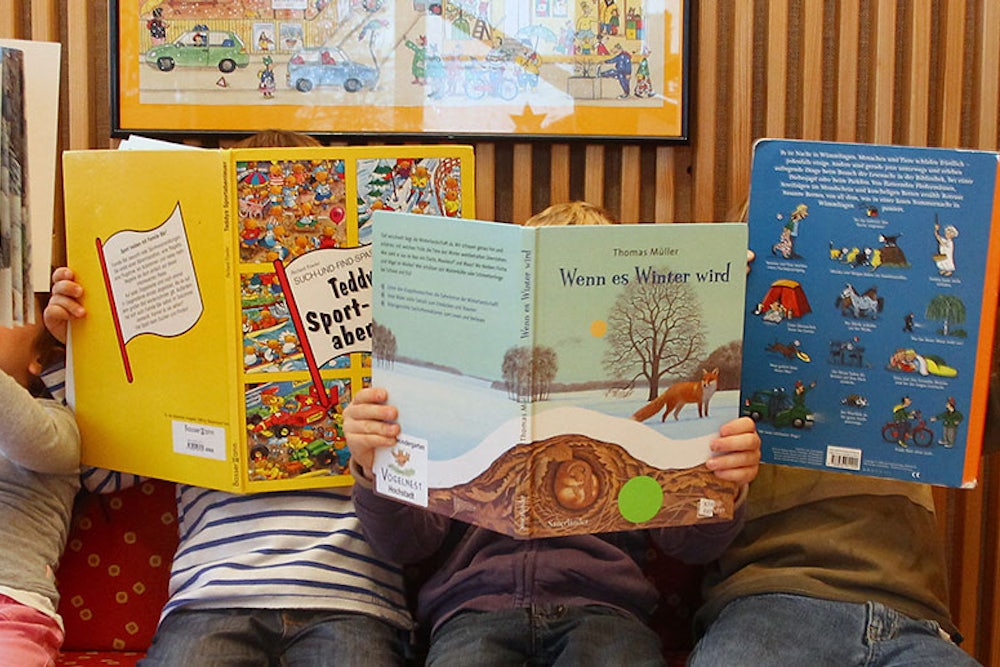Why do we give books to children? Common answers to that question involve the use of words like “expand”, “open” or “broaden”, followed by “minds”, “hearts”, “horizons” or “imaginations”. Sad then, that many books for children do just the opposite; they peddle stereotypes, close minds to new experiences and offer limited horizons.
The Let Toys Be Toys campaign, which last year persuaded 13 retailers to remove “Boys” and “Girls” signs from stores, is working with Letterbox Library, Inclusive Minds and For Books’ Sake to persuade the publishing industry to drop these labels from books. The Let Books Be Books petition launched for World Book Day, 6 March, asks children’s publishers Usborne, Buster Books, Igloo Books and others to stop labelling children’s activity, story and colouring books as for boys or for girls.
Really disappointed to see these on the shelves at @johnlewisretail - sort it out!!! @LetToysBeToys @PinkstinksUK pic.twitter.com/1CG1fT6b0Z
— Anna Maria Barry (@AnnaMariaB87) March 2, 2014Children are individuals. They should feel free to choose their own interests, not feel that they’re supposed to like or reject certain things. And anyone who chooses a gift based only on a child’s gender is making some massive, and quite likely wrong, assumptions about what that child may like.
Campaign supporters regularly share photos of “boy” and “girl” books with predictably lazy stereotypes on the cover. These are usually colouring, sticker and activity books, although “Stories for Boys” and “Stories for Girls” are also common. Classic novels, great for all children to read, are bundled together with the words “girls” or “boys” slapped on the box. Separate cookery books seem particularly ridiculous; the suggestion being that boys eat pizza and burgers, while girls prefer pink iced cupcakes. We’ve even seen “girls” and “boys” versions of The Bible.
Typical themes for boys include robots, dinosaurs, astronauts, vehicles, football and pirates; while girls are allowed princesses, fairies, make-up, flowers, butterflies, fashion and cute animals. There’s nothing wrong with these things, but it is wrong when they are repeatedly presented as only for one gender. Girls can like pirates and adventure, boys can like magic and dressing up. Why tell them otherwise? Why tell them that boys and girls should like different things, that their interests never overlap, that there are greater differences between genders than between individuals?
more stereotypes for children to absorb this #Christmas, from @Igloo_Books & sold by @LoveWilko pic.twitter.com/2lZhjj0shU
— Let Toys Be Toys (@LetToysBeToys) December 14, 2013It’s accepted practice to target products at one segment of the population, but when it comes to children’s books it’s morally questionable to promote gender stereotypes. Children take messages about what’s “for girls” or “for boys” seriously.
“Books should give children the chance to explore new things and ideas, and labelling books, and certain subjects, as only for one gender prevents them from doing this,” says Alexandra Strick, of children’s literature project Inclusive Minds. Her co-founder Beth Cox, adds, “These books reinforce stereotypes about what it means to be a boy or a girl, and therefore make children who don’t conform to these stereotypes more vulnerable to bullying and at risk of low self-esteem”.
The campaign also aims to raise discussion on wider issues around gender and children”s books, such as the fact that male protagonists still outnumber female characters by two to one in children’s picture books, or the belief, often expressed by publishers, that boys won’t read books with girl leads.
These issues are connected to a wider culture of inequality. The founder of For Books’ Sake, Jane Bradley, says, “From gendered children’s colouring books to chick-lit book covers illustrated with pink cursive fonts, handbags and cupcakes, the publishing industry aggressively reinforces conventional gender roles to its readers from childhood onwards. This gendered marketing normalises and perpetuates limiting, antiquated stereotypes, and we believe it’s time for the publishing industry to put it where it belongs; in the past”.
Kerry Mason, co-director of the not-for-profit social enterprise Letterbox Library agrees. “This campaign is testament to a growing voice of dissent. We have a very proud and rich tradition of children’s publishing in the UK. But increasingly, parents and teachers feel that children’s own book choices are being limited by publishers’ gendered marketing campaigns.
“At Letterbox Library, we have spent the last 30 years selecting books which give children the widest possible choices in what they read. Our selection is increasingly being threatened by a type of marketing which uses book labelling and covers which restrict a book’s readership. We simply cannot stock books marketed in this way. Gendered marketing is anti-choice and, for us at least, there really is no profit in it. Nor is there much respect for children in it!”
Join the Twitter conversation on the #LetBooksBeBooks hashtag and sign and share the petition if you agree that it’s time for children’s publishers to just let books be books.
This piece first appeared on newstatesman.com.
